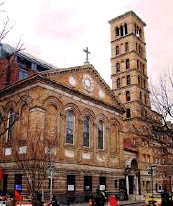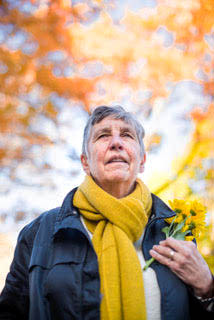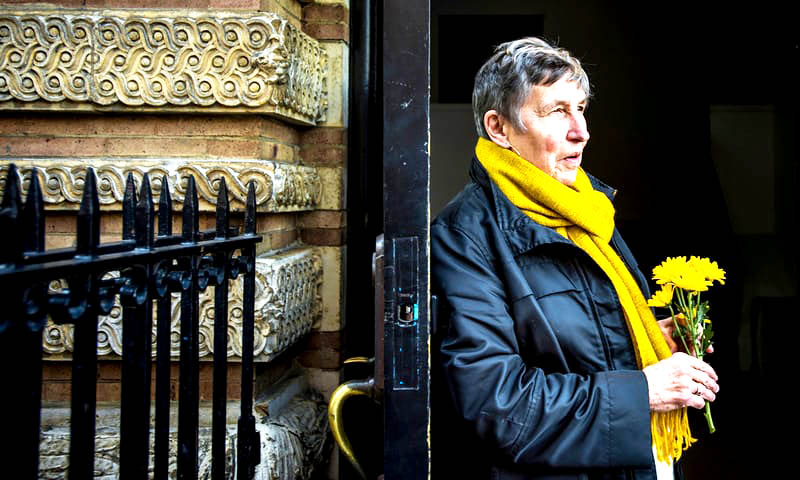Spending time with The Rev. Dr. Donna Schaper, one of the founders of Bricks and Mortals in New York City, is always time well spent. She’s a remarkable woman who is always full of ideas, initiatives, and opinions. She has been described as a career vagabond, an ideological contortionist, a political pontificator, a chic peasant, and many other things. Among the many congregations she has served is Judson Memorial Church, where she was Senior Pastor for over 15 years. She also teaches Leadership at Hartford International University for Religion and Peace (formerly Hartford Seminary) and has written 39 books.

Judson Memorial Church, New York City. Courtesy of Judson Memorial Church
.

Rev. Dr. Donna Schaper
Gianfranco Grande: What is Bricks + Mortals? How did it start?
Donna Schaper: Bricks + Mortals (B+M) started in 2018 as a question: why is a church as vital as Judson Memorial always being held back by delayed maintenance rather than pushing forward into artistic, social, and spiritual activity? We wanted to get to the bottom of the matter rather than just be reactive, and we realized that we were focused on the immediate rather than on rebuilding our infrastructure. We had to fix the roof. We did. We more than fixed it. We put on a new roof using terra cotta tiles matching the original tiles specified by Stanford White in 1892, which would last 100 years rather than the last three roofs which each lasted thirty years.
That longer term perspective opened our eyes to other potentials, some of which are now realized. The real shift happened in our brains. Our building WAS our mission. It wasn’t sinful, as we had previously thought, to spend money on what we called ourselves or our building. It was fundamental because the building – and its roof and bathrooms and elevators – were the body of God into which many spirits flowed.
Bricks and Mortals started as a shift in thinking from short term to longer term and in a reimagining of the holiness of a building. Then, because we were in New York City, we found others who were looking at the same conundrum in both faith-based places and in other worlds: real estate development, politics, architecture, urban planning and more. The excitement of the Bricks and Mortals model, very much dictated by our own peculiar site in a great neighborhood in a great city, was this blend of sacred and secular partnership and thinking.
GG: Why do we need an organization like B+M in our world?
DS: If I say because God delights in bricks and mortals, would that be considered too facile an answer? I’ll start there and become less theological. If the purpose of life is to praise God and to love God forever, as my old friend Calvin thinks, then the way we build and live in buildings is a pleasure to God. Our skins and shells do delight God. We need delight and beauty in our world. That’s the first reason.
We also need to organize our delight into systems that self-care, self-govern, and increase what Thich Nhat Hahn calls SOVEREIGNTY. We need to manage ourselves much better than we do. Delaying maintenance is a kind of sin in that it offends the divine. Getting confused about what to do with our skins and shells has a long human history. We are the species that does defile its own nest. So, the organization is crucial. The intention is crucial. The planning and minutes of the board meetings are crucial.
“Self-care” has become a kind of cliché. So has “My house is a mess.” These are not funny matters — that we don’t care for ourselves or don’t care for our houses. They are very serious consequences of a kind of “time famine” which becomes a spiritual famine. We need time feasts, spiritual feasts, and beautiful buildings because these praise God.
GG: What can you tell us about the decline of congregational capacities to preserve their buildings?
DS: I personally think the decline is directly related to a lost path in theology. We began to think that taking care of the building was antithetical to taking care of the poor or the homeless. When I went to seminary, my mentors all fought their boards to spend money on the mission budget not the building budget. No doubt there was a previous, lost path when congregations overdid their buildings and under did their care of their communities. In fact, I also see that path as diversionary. But whatever happened, there was a kind of neglect of sustainable thought and action. I guess we thought a boiler was going to last forever. It never was going to do that, especially if you neglected annual maintenance. The binary, the split between the building types of trustees and the missional kinds of deacons, didn’t help things either. Why didn’t we develop a both/and rather than an either/or focus? How did care of our spiritual homes become so politicized?
GG: You often speak of an “Easter Approach” what do you mean by this definition?
DS: We are pretty dead right now. A lot of life has gone out of our buildings. Weeds peek through our sidewalks. Letters on the front sign fall down. Junk piles up. Most congregations need a complete “de-dowdyizing”. They smell like Grandma’s house. (Yes, I am a grandma so no offense intended.) We wonder why young people don’t come and the answer is right there. We don’t look like the places where they live and work. We look like we tethered ourselves to the 1950s and have no intention of coming out or breaking free.
GG: Another concept you have expressed often is “removing the pews” – both physically and as a metaphor for something more significant. Of course, pews often contribute to the cultural and architectural character of an older church, so tell us why it might be helpful for a congregation in 2021.
DS: By removing the pews (the title of my forthcoming book) I mean removing them from our minds and spirits — the way we think, our epistemological, our narratives about ourselves — and emptying those spaces spiritually and then physically. When you open your mind and heart, God rushes in with new ideas. Pews imply rigidity. They imply discomfort. They imply preachers who are wagging their fingers at you. They are NOT all those things, necessarily, but they need a rebranding. People are trying to get away from shame and blame theology, rigid constructs. They want more fluidity, more acceptance, more grace.
When you remove the pews, you can still set up chairs and sit down. You can even buy more comfortable chairs. When you empty the space, you also refill the space. It is a cycle of emptying and filling. Plus, there is a very practical advantage. When a congregation doesn’t fill its pews, when the pews look EMPTY, the message is very difficult. People feel like they showed up in the wrong place at the wrong time. And they kind of did. Removing the pews makes a gospel kind of statement. We’re interested in the stranger. We’re interested in their experience of us. We want to set a number of chairs that is the right number in a circle so there is a place for you, but not one where everybody stares at you.
GG: Bricks + Mortals is an organization based in NYC, but could this model be translated into other cities?
DS: Absolutely. Getting organized is always the best approach to any problem. Our model is bringing together mostly faith leaders, combined with people that have the expertise we need. It is a blend. It is fundamentally ecumenical, even interfaith. It teaches cultural competency by bringing people together who normally don’t even know they are all plowing the same fields in real estate, cultural density, anti-gentrification, open space, and place. Of course, not everybody is worried about air rights (property interest in the unused space above an existing building, which in some cities can be monetized and sold to a real estate developer) the way we are. But working contextually in any kind of city or town or rural crossroads is more than adaptive; it is the right way to go. By the way, we have a Lilly Endowment grant that will allow us to experiment with our model in five cities.
GG: Can you tell us more about the partnership between Bricks + Mortals and Partners for Sacred Places to create a national model to teach congregations about sustainability, adaptive reuse, and space-sharing?
DS: The partnership is like a big brother to a baby sister, sibling-esque. The older brother (Partners for Sacred Places) is much wiser, experienced and has preservation at his heart. The sister (Bricks + Mortals) is just moving out of being a baby sister but finding it a grace and gift to be able to stay close to the elder. Also, the younger sibling grew up in a very New York City-centric environment and is wondering about what form the next chapter should take. Cooperating with Partners (and also Hartford International University for Religion and Peace) on the Lilly grant, which goes national in an experimental form, to see if what New York has learned can benefit others or not, is not a small matter. The siblings get along very well, and that is a blessing. And Partners is a wise elder: encouraging the young as it goes on.
GG: You never stop! What will be your next challenge?
DS: I have stopped a bit. I have re-wired and am working in a part-time, lovely setting on the east end of Long Island, with people who are the type you would imagine live on the edge of the country. Interesting, stumped, looking for inner peace from their regular bustle. Artists, farmers, lesbians. I like the mix a lot. Judson was magnificent for 15 years, but it took all I had and then more. I suppose I am one of those COVID people who just realized during the pandemic she wanted a change of pace and way. Anyway, I will be teaching with you in these five cities and playing tennis and teaching Leadership at Hartford International Seminary for Peace and Religion. I like being a part of change — because I’m pretty sure lovely change is the most sustainable thing you can do.

